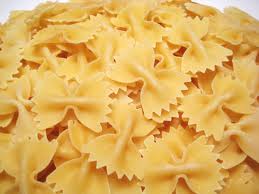Pasta is a type of noodle and a staple food of Italians and the first reference to it dates back to 1154. It is used to refer to the variety of pasta dishes. Typically pasta is made from durum wheat flour mixed with water and formed into sheets or various shapes, cooked and served in any number of dishes. Pastas may be divided into two broad categories, dried (pasta secca) and fresh (pasta fresca).
Fresh pasta was traditionally produced by hand, sometimes with the aid of simple machines, while the dry pasta was manufactured in a large scale. But today many varieties of fresh pasta are commercially produced by large scale machines, and the products are available in supermarkets.
Both dried and fresh pasta come in a number of shapes and varieties, with 310 specific forms known variably by over 1300 names having been recently documented. In Italy the names of specific pasta shapes or types often vary with locale.
Common forms of pasta include long shapes, short shapes, tubes, flat shapes and sheets, miniature soup shapes, filled or stuffed, and specialty or decorative shapes.
In Italian cuisine, both dried and fresh pastas are classically used in one of three kinds of prepared dishes. The cooked pasta is served with a complementary sauce or condiment or the pasta is part of a soup-type dish or the pasta is incorporated into a dish that is subsequently baked.
Pasta is generally a simple dish, but comes in large varieties because it is a versatile food item. It can be prepared by hand or food processor and served hot or cold. Pasta sauces vary in taste, color and texture.
When choosing which type of pasta and sauce to serve together, there is a general rule that must be observed.
Simple sauces are ideal for long and thin strands of pasta while tomato sauce combines well with thicker pastas. Thicker and chunkier sauces have the better ability to cling onto the holes and cuts of short, tubular, twisted pastas. It is important that the sauce does not overflow the pasta.
Basic pasta dough has been wheat flour with durum wheat being used in the South of Italy and soft wheat in the North. Regionally other grains like barley, buckwheat, rye, rice and maize, as well as chestnut and chickpea flours are used. The use of rice, maize and whole durum wheat has become commercially significant to satisfy the health fads and coeliac sufferers.
Grain flours may be supplemented with cooked potatoes. Hens’ eggs, duck’s eggs, milk or cream, olive or walnut oil, wine, ink from octopus, squid or cuttlefish, and even pigs’ blood are used as the liquids. Other additions to the basic flour-liquid mixture are vegetables purees such as spinach or tomato, mushrooms, cheeses, herbs, spices and other seasonings.
Pasta is generally served with some type of sauce; the sauce and the type of pasta are usually matched based on consistency and ease of eating. Northern Italian cooking uses less tomato sauce, garlic and herbs. In south Italian cuisine, Tomato sauces are used in addition to more complex variations such as fresh vegetables, olives, capers or seafood.
There are several health benefits to consuming pasta, especially whole wheat pasta. Whole wheat is low in calories and contains considerable amounts of minerals including, magnesium, iron, calcium, potassium, zinc, selenium and manganese. Minerals are important for the body because they help with the structure of bones, regulate heart beat, maintain muscle, and take part in regulating cell growth.
Pasta is normally an intake combined with other foods rich in nutrients. Fiber can be found in vegetables, beans, fish, tomato sauce, cheese.
Pasta contains complex carbohydrates releasing energy slowly for a longer time. Pasta is cholesterol free also contains a small amount of sodium, iron and Vitamin B. Pasta has a low Glycemic Index and its carbohydrates are slowly absorbed.

